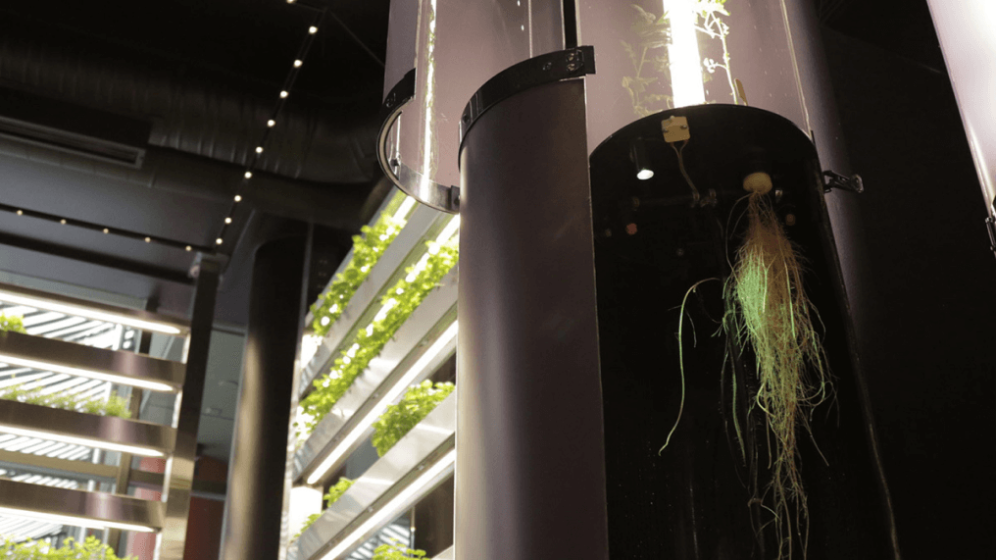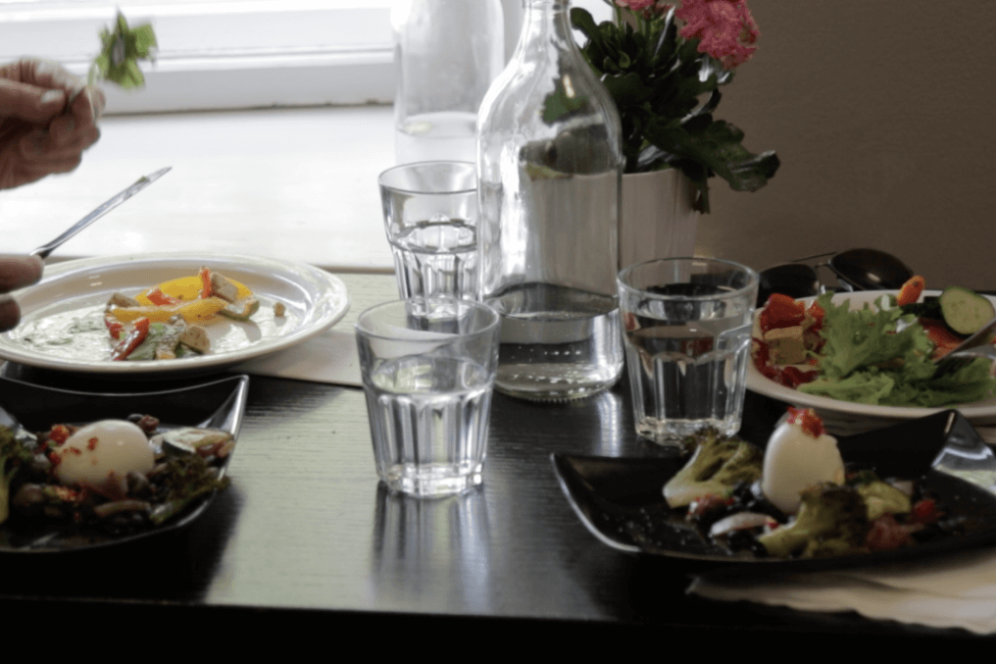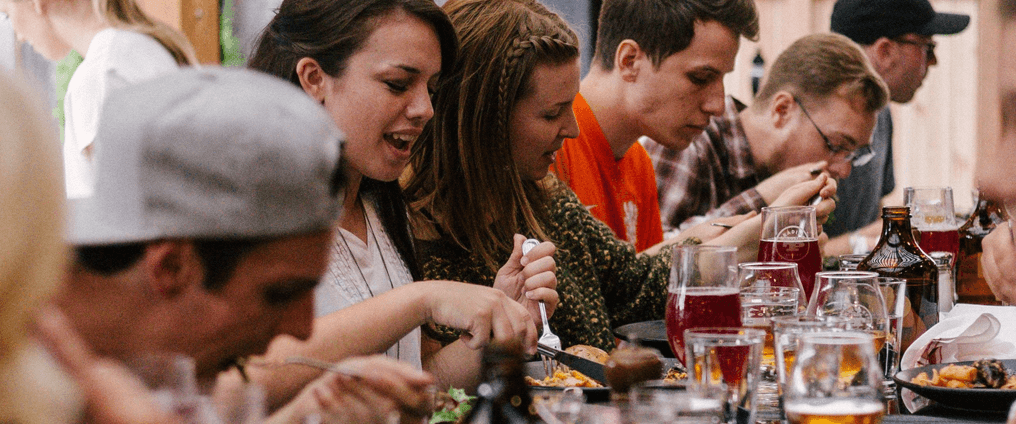At a glance
Citizens spend more in restaurants than supermarkets
As such they can be influential in shifting to a circular economycircular economyA systems solution framework that tackles global challenges like climate change, biodiversity loss, waste, and pollution. It is based on three principles, driven by design: eliminate waste and pollution, circulate products and materials (at their highest value), and regenerate nature. for food
Three restaurants in Helsinki approach this in different ways
What are the key takeaways for the wider restaurant industry?
A sector that is ripe for positive transformation
One of the pleasures of urban life is the wide choice of restaurants available. In large cities like New York and London, there is one restaurant or café for every 30 people. The evidence suggests that the popularity of restaurants is increasing steadily. In May 2015, according to research from the US, for the first time in human history, global spending on restaurants exceeded food purchases from grocery stores. In economic terms, the global restaurant industry has been estimated at 5% of the overall global economy.
Given its size and nature, the restaurant industry is resource hungry and generates large volumes of waste. Resources used include both food ingredients and technical equipment, water, and energy. Waste includes leftover food as well as processing, packaging, and structural waste (underutilised assets). According to a recent WRAP report, in the UK, about 1.5 million tonnes of waste is generated by the hospitality and food service sector each year, about 40% of which is organic waste. This corresponds to an average cost per outlet of £10,000, which in the restaurant and pub sector adds up an economic loss of over £1 billion.
The benefits of reducing losses in the food industry was analysed in McKinsey/Sitra’s 2015 report – The opportunities of a circular economy in Finland. The study identified a number of different approaches to address the problem, 20% of which is associated with restaurants. Potential interventions include apps that facilitate redistribution of uneaten food such as TooGoodtoGo; cultural mindset shifts, for example in the use of ‘doggy bags’ to take uneaten food home; and digital technology in kitchens that measures and analyses canteen waste, allowing chefs to make smarter buying decisions, such as Winnow and LeanPath.
Effective management and reduction of waste streams is an important step for the urban economy and the environment. However, the circular economy takes a more systemic perspective, where the concept of waste is actually eliminated. Instead, discarded organic materials are viewed as valuable feedstock, cycling through different stages of a circular economy for food, and eventually closing the loop back to the soil.
In Helsinki three pioneering restaurants have attempted to incorporate circular principles into the design and operation of their business. The question is, how might we apply these lessons to the wider industry?

Cities will consume 80% of food by 2050 (Image: Jeffrey Swanson/Unsplash)
Ultima – high-tech and hyperlocal
Finnish chef and broadcaster Henri Alen is comfortable experimenting with new culinary ideas. His previous restaurant, Finnjavel, had a deliberate lifespan of 730 days, to force him to rethink his food to suit the pace of change in the world at large.
Henri’s latest venture was born from this mindset of adaptation and reinvention. Launched in May 2018, Restaurant Ultima is intended as a stage for experimentation, exploring what food production and consumption could look like in the future. The question at the heart of Ultima is: can we bring farms into cities? This question emerged from the experience of Finnjavel, which although successful in using local and seasonal ingredients, still generated waste packaging, transport impacts, and other potential negative impacts. By growing ingredients on the restaurant premises, these impacts could be addressed.
Hyperlocal and high-tech are the two key bywords for Ultima. The restaurant building functions both as an eating space, but also as a productive laboratory for hydroponic and aeroponic cultivation systems, insect farming using food preparation waste, mushroom-growing on coffee grains, algae growing, and other innovative food production methods.
“New things can be scary to people,” says Chef Henri and he is keen that with the support of Finnish innovation fund Sitra, the example of Ultima can mitigate the risk that future restauranteurs experience around new untested technology, by experimenting to discover pitfalls and optimisation in the use of the technology. As the late Anthony Bourdain observed: “Without an experimental mindset, a willingness to ask questions and try new things, then nothing will change for the better.” As pioneers in indoor food production within a restaurant building, the team behind Ultima can be happy that they are living up to this ideal.

Hydroponic and aeroponic systems in Restaurant Ultima (photo: Nick Jeffries)
Nolla – Zero-waste ideology
After learning from Danish chef Matt Orlando that European restaurants produce on average 70,000kg of waste per year, three chef friends – Carlos Henriques, Luka Balac and Albert Sunyer – decided to challenge existing waste management conventions in the restaurant sector by opening in March 2018 a restaurant that completely does away with bins. Nolla, meaning ‘zero’ in the Finnic language, refers to the zero-waste ideology permeating every aspect of the restaurant’s design and operation. Chef Carlos was the most sceptical of them all that it could work, but his opinion quickly turned around when he saw that “within 2 weeks of opening we had reduced our waste by 80%”.
The team at Nolla pursues the core idea of eliminating waste in a number of ways. Ingredients are procured from local producers, who are aligned with or persuaded by Nolla’s vision. In this way no single-use packaging enters the restaurant premises. There are no bins in the conventional sense. Food waste is directed to an Oklin compostingcompostingMicrobial breakdown of organic matter in the presence of oxygen. machine which, through shredding, microbe seeding, and temperature control, transforms the restaurant’s organic discards into soil-enhancing material. This ‘soil material’ is then returned to suppliers to loop back to their farms and production areas.
Their zero-waste philosophy does not only apply to food. The interiors, crockery, glassware, and even napkins have been carefully selected because they are made from reused or recycled materials. For example, the chairs are made from wood offcuts from the exhibition industry; the cooking oil is delivered in 200 litre reusable containers; and napkins are made from recycled plastic.
A positive, but unplanned, consequence of adopting this philosophy, has been the way that the ‘zero waste’ attitude has spread to the restaurant’s stakeholders. Chef Luka cites an example related to the Havikkimestari app – technology that they use in the kitchen to collect data, in order to inform better decision-making about food procurement. For one client of this app, the technology not only saved €20,000 in the seven kitchens in which it was installed, but it also impacted the personal habits of canteen workers, who became more conscious about and adjusted their own personal habits in relation to waste. This positive mindset change can be seen in both staff and suppliers. One of the restaurant’s Catalonian wine providers, after learning about Nolla’s ambitions, redesigned their labelling to eliminate single-use plastic in all of their bottles. This is a clear example of how a positive mission and ambition can be infectious.
“We should all save money, or make money,” argues chef Carlos, talking about the win-win potential at the heart of Nolla’s philosophy. For an idea to be successful and scale up, the restaurant needs to be economically viable. When asked to sum up what the three friends are trying to accomplish, the immediate response is: “serve great food, make money but do so in a circular economy way”.

Carlos, Albert and Luka - three friends on a mission (Photo: Nick Jeffries)
Loop – Redefining ‘waste’
According to the Natural Resources Institute of Finland, pre-consumer food waste originating from grocery stores, supermarkets, and food producers amounts to 65 million kilos per year. A small proportion (10–15%) is distributed as food aid, but the majority is incinerated or goes into landfill. All of this food is perfectly edible, but has been withdrawn from the supply chain because of reasons such as aesthetics or labelling conventions. The result is not only wasted resources and carbon emissions, but also an economic value loss of over €200 million.
Restaurant Loop was set up to realise the opportunities offered through shifting the perception on surplus food. Johanna Kohvakka, the restaurant founder, has established partnerships with six suppliers/supermarkets around the city, who divert 600 kg of surplus food each day into Restaurant Loop’s operation. Once in the kitchen, chefs transform the ingredients into high-quality canteen food, gourmet meals, and even artisanal ice cream – all inspired by the availability of different food types. Any remaining edible food is directed to charities, while unavoidable food waste is composted.
“If I had a magic wand and could change one thing about the current system,” says co-founder Satu Vaino, “it would be to make people have more respect for food and the resources needed to produce food.” She then lays down a challenge to other restaurants: “Look to your local stores, see what they are throwing away. Start close, look for local partnerships, look for simple steps to create a circular economy for food.”

Restaurant Loop - tasty dishes from surplus food (Photo: Nick Jeffries)
What else can chefs and restaurants do?
Experimenting in a small independent restaurant is a completely different proposition to driving change in a large restaurant chain where systems and supply chains are firmly in place, staff have been trained on specific tasks, consistency is required across hundreds, even thousands, of locations and avoiding reputational damage is paramount. Large catering operations require a different approach to becoming circular. Organisations such as UK-based Sustainable Restaurants Association (SRA) who, with their sustainability framework and large network of food service players, have been instrumental in helping ideas replicate and scale up to this size of operation. IKEA, an Ellen Macarthur Foundation member, demonstrates what this could look like in practice.
IKEA has approximately 400 stores in almost 50 countries. Their restaurants feed about 660 million people each year and serve approximately 2 million meatballs every day. The Swedish furniture giant takes a number of different approaches to improve health outcomes and circularity in their food business. Innovation in ingredient choices as well as the creation of alternative versions of established classics, such as the iconic meatball or hotdog, is one lever they use. The key challenge is to attain or exceed the tastiness of the original, but use ingredients such as lentils, carrots, kale, and quinoa, that are better for the health of their customers and help food resource production stay within planetary boundaries in relation to key issues such as carbon dioxide emissions, chemical pollution, biodiversity etc.
Another tool associated with large catering operations is buying power. High-volume procurement can be used as a powerful force for good if there is an underlying commitment to procure ingredients that are produced in a regenerative and equitable way. Several independent certification schemes have been set up to encourage such practices, including UTZ/Rainforest Alliance for coffee, tea, and cocoa or the Marine Stewardship Council (MSC) certification for seafood.
Finally, there is the use of technology, manifested in various ways such as redistribution of edible food, facilitation of smart pricing systems or the provision of simple measuring and monitoring systems. One such system is Winnow – a food waste monitoring and analytics software that has been installed in 35% of IKEA’s kitchens, leading to an estimated 1 million meals saved within just a few months. As an unexpected bonus, 50% of canteen workers exposed to this technology have been inspired to reduce food when they go home.
The last word must go to the chef-philosopher Dan Barber, chef at Blue Hill at Stone Barns in Massachusetts, and author of the Third Plate: Field Notes from the Future of Food. In Barber’s world, the restaurant is an engine that can improve soils, regenerate farmland, and unlock flavour. A few years ago, he returned to his grandparents’ farm after almost two decades, where he observed a precipitous reduction in soil fertility, due to a linear outflow of nutrients as a result of year-on-year hay harvesting.
Barber set about restoring the health of the soil, through the introduction of animals, rotational crops, and other regenerative farming practices. The food that was created as a by-product of improving soil and better management of the farmland, determined what was fed into and prepared in his restaurants. For example, introducing goats to stop the encroachment of surrounding woodland, meant that soon after braised goat shoulder found itself on the menu. Such a philosophy also saw him creating innovative dishes with crops, such as rye, that are traditionally associated with nutrient cycling rather than food crops.
Barber is convinced that healthy soils translate into great flavour, so his restaurant operations are designed around regenerating the soil. In his mind, it is simple: “To support the continual improvement of the whole system is the goal, and this leads to better flavour.”
Key takeaways
A positive mindset can be infectious! Striving to be more circular can be a great motivator for staff and suppliers, impacting things well beyond the place of work
Technology exists to convert kitchen waste into soil enhancers without taking up much space and in a short time duration
Suppliers are willing to come along on the journey with you, if you tell them a good story and share the benefits
There are huge amounts of perfectly edible and tasty ‘surplus’ ingredients all around the city, if you are willing to be flexible and form collaborations with local retailers and producers
Talk to people within the industry. Everyone who has introduced new technology or practices will have tips or advice on what went well and how they would do things in the future. SharingSharingThe use of a product by multiple users. It is a practice that retains the highest value of a product by extending its use period. learnings is one of the most useful sources of information
New technology and approaches mean cultivating food in the restaurant is becoming more and more viable, which can lead to maximum freshness and eliminate impacts of packaging and transport
By separating processing waste from food waste, restaurants can maximise value capture from organic resources and play a significant role in closing the nutrient loop back to farms
Simple technology installed in the kitchen, for example a weighing scale under the bin, can increase awareness and allow better decisions to be made about procurement
Chefs have an important influence as food designers, to create innovative and tasty meals, using diverse and new ingredients that build healthy natural and societal systems
Large catering operations can innovate, use their significant buying power, and install simple technology to bring about change
Further relevant material:
Food Made Good - an initiative of the Sustainable Restaurant Association
The Chef's Manifesto - part of the SDG2 advocacy hub






